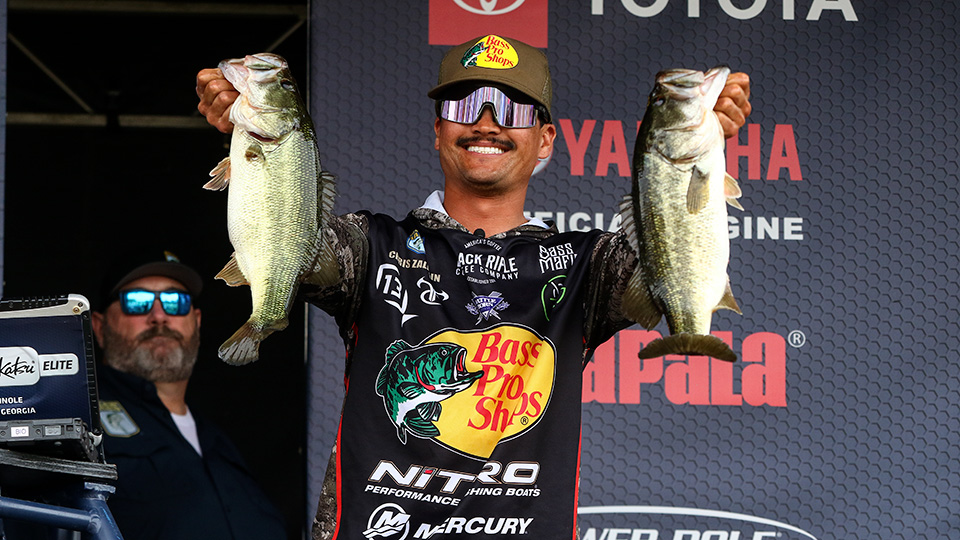
Whenever I fish in the Carolinas, I have blueback herring on my mind. Bass forage heavily on this species in a number of lakes. That includes Lake Murray where the next Bassmaster Elite Series event takes place.
Diadromous blueback herring migrate between fresh and saltwater. However, they have been introduced into several freshwater impoundments where they spawn successfully.
Shad are also a major bass forage in Murray and in other lakes that support bluebacks. But you have to adjust your baits and presentations to whichever of these species the bass are feeding on. I’ll be focusing on the bluebacks at Murray.
Faster is better
Because blueback herring are saltwater fish, they move very fast, and they stay on the move. You have to retrieve your baits at a high rate of speed to get bites. They spawn in springtime by roaming from flat point to flat point to spread their eggs.
Slower retrieves dupe bass that feed on shad. But bass that feed on bluebacks demand a quick-moving bait, especially in clear water. A slow retrieve just doesn’t look natural to them.
High speed casting reels help you maintain upbeat retrieves with less effort. Every one of my rods will be matched with a 13 Fishing A2 reel that has an 8.3:1 gear ratio. You need a fast reel in order to work many blueback imitating lures properly.
The striper connection
Lakes that support blueback herring often have striped bass as well. Stripers pillage the bluebacks right along with the black bass. If you find stripers feeding on bluebacks, you can count on bass being there too.
You will inevitably catch stripers while casting for bass, because they respond to the same lures the bass do. That’s maddening during a tournament, but you have no choice but to wade through them.
It will help if you bear in mind that stripers usually feed within 6 feet of the surface. Those fat, lazy largemouth typically hang beneath the stripers 6 to 12 feet deep.
When one of my sinking lures hits the water, I hesitate for two to four seconds before I start the retrieve. The stripers are less likely to nab the bait as it sinks because it isn’t acting like a hyperactive blueback.
Forget finesse
This is all about power fishing with big baits. Bluebacks are slimmer than gizzard shad, but they’re typically 5 to 7 inches in length. My most productive blueback imitator is a white 6-inch Dart, a fluke-type lure from Googan Baits.
I rig it on a Googan Gold Series Weighted Dart Swimbait Hook with a 3/16-ounce weight. I can cast it a long way across points with a 7-foot, 3-inch, medium-heavy 13 Fishing rod loaded with 15-pound Seaguar InvizX Fluorocarbon.
I chop the rod downward similar to twitching a jerkbait. I work the Dart 4 to 8 feet deep, right in the sweet zone.
Bass Mafia’s 6-inch Daingerous Swimbait is another killer for me. I rig it on a 3/8-ounce belly style hook. The beauty of the Daingerous is that it doesn’t roll when you burn it. I also retrieve it 4 to 8 feet deep and with the same tackle I use with the Googan Dart.
Run and gun lottery
When a school of bluebacks show up on a hard-bottom flat point to spawn, any bass in the area go into a feeding frenzy. If the bluebacks aren’t there, don’t waste time waiting for them to show up.
Visible schooling activity tells me where I need to be casting about 30% of the time. In most instances, you have to pull up to a point and look for the baitfish with your electronics. If you don’t see the bluebacks on your display, run to another point.
No doubt many of my Elite competitors will be doing the same thing. It becomes something of a round-robin lottery. You need to be one of the lucky ones who lands on a point just when the bluebacks show up.
When you hit the jackpot, it’s possible to catch a limit of bass in five casts. And they’ll be good ones, the 3 1/2- to 5-pounders I need to pull myself up in the Bassmaster Angler of the Year standings.





